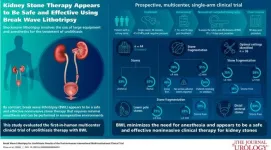(Press-News.org) ITHACA, N.Y. – Cornell University researchers have created microscale robots less than 1 millimeter in size that are printed as a 2D hexagonal “metasheet” but, with a jolt of electricity, morph into preprogrammed 3D shapes and crawl.
The robot’s versatility is due to a novel design based on kirigami, a cousin of origami, in which slices in the material enable it to fold, expand and locomote.
The team’s paper, “Electronically Configurable Microscopic Metasheet Robots,” published Sept. 11 in Nature Materials. The paper’s co-lead authors are postdoctoral researchers Qingkun Liu and Wei Wang. The project was led by Itai Cohen, professor of physics. His lab has previously produced microrobotic systems that can actuate their limbs, pump water via artificial cilia and walk autonomously.
In a sense, the origins of the kirigami robot were inspired by “living organisms that can change their shape.” Liu said. “But when people make a robot, once it’s fabricated, it might be able to move some limbs but its overall shape is usually static. So we’ve made a metasheet robot. The ‘meta’ stands for metamaterial, meaning that they’re composed of a lot of building blocks that work together to give the material its mechanical behaviors.”
The robot is a hexagonal tiling composed of approximately 100 silicon dioxide panels that are connected through more than 200 actuating hinges, each about 10 nanometers thin. When electrochemically activated via external wires, the hinges form mountain and valley folds and act to splay open and rotate the panels, allowing the robot to change its coverage area and locally expand and contract by up to 40%. Depending which hinges are activated, the robot can adopt various shapes and potentially wrap itself around other objects, and then unfold itself back into a flat sheet.
Cohen’s team is already thinking of the next phase of metasheet technology. They anticipate combining their flexible mechanical structures with electronic controllers to create ultra-responsive “elastronic” materials with properties that would never be possible in nature. Applications could range from reconfigurable micromachines to miniaturized biomedical devices and materials that can respond to impact at nearly the speed of light, rather than the speed of sound.
“Because the electronics on each individual building block can harvest energy from light, you can design a material to respond in programmed ways to various stimuli. When prodded, such materials, instead of deforming, could ‘run’ away, or push back with greater force than they experienced,” Cohen said. “We think that these active metamaterials – these elastronic materials – could form the basis for a new type of intelligent matter governed by physical principles that transcend what is possible in the natural world.”
For additional information, read this Cornell Chronicle story.
Cornell University has dedicated television and audio studios available for media interviews.
Media note: A video can be viewed and downloaded here: https://cornell.box.com/v/Kirigamimicrorobots
-30-
END
Microscale robot folds into 3D shapes and crawls
2024-09-11
ELSE PRESS RELEASES FROM THIS DATE:
New noninvasive technique provides effective treatment for urinary stones
2024-09-11
September 11, 2024 — A noninvasive ultrasound technology called Break Wave™ lithotripsy (BWL) offers a safe and effective new option for treatment of urinary stones, reports a clinical trial in the October issue of The Journal of Urology®, an Official Journal of the American Urological Association (AUA). The journal is published in the Lippincott portfolio by Wolters Kluwer.
"In this initial experience, BWL provided a high treatment success rate, using a portable technology that can be used in a range of settings, without the need for anesthesia" comments lead ...
Researchers uncover new infection-fighting molecules through “molecular de-extinction”
2024-09-11
A new study led by Cesar de la Fuente, PhD, Presidential Assistant Professor of Psychiatry, Microbiology, Chemistry, Chemical and Biomolecular Engineering, and Bioengineering at the University of Pennsylvania, has uncovered sequences for infection-fighting molecules in the genomic data of extinct species. This most recent study in the emerging field of “molecular de-extinction”, pioneered by Prof. de la Fuente, offers the potential to develop new antimicrobial treatments in the fight against rising antibiotic resistance.
The study, published in Cell Reports Physical Science, analyzed genomic data from the extinct moa, a flightless bird from New Zealand, ...
Keeping mold out of future space stations
2024-09-11
COLUMBUS, Ohio – Mold can survive the harshest of environments, so to stop harmful spores from growing on future space stations, a new study suggests a novel way to prevent its spread.
Researchers created a predictive approach for modeling unintended microbial growth in critical spaces and applied it to life on the International Space Station.
An analysis of dust samples obtained from the space station found that repeated elevated humidity exposures for even a short time can lead to rapid microbial growth and composition changes in dust that make it easier for microbes, ...
"It feels like I'm moving my own hand". A research team from the Scuola Superiore Sant'Anna in Pisa has developed the prosthesis of the future, the first in the world with magnetic control
2024-09-11
Pisa, 11 september. It is the first magnetically controlled prosthetic hand, that allows amputees to reproduce all movements simply by thinking and to control the force applied when grasping fragile objects. No wires, no electrical connection, only magnets and muscles to control the movements of the fingers and enable everyday activities such as opening a jar, using a screwdriver, picking up a coin.
A research team from the BioRobotics Institute of the Scuola Superiore Sant'Anna in Pisa, coordinated by Prof. Christian Cipriani, has ...
Self-medicating gorillas and traditional healers provide clues for new drug discovery
2024-09-11
Four plants consumed by wild gorillas in Gabon and used by local communities in traditional medicine show antibacterial and antioxidant properties, find Leresche Even Doneilly Oyaba Yinda from the Interdisciplinary Medical Research Center of Franceville in Gabon and colleagues in a new study publishing September 11 in the open-access journal PLOS ONE.
Wild great apes often consume medicinal plants that can treat their ailments. The same plants are often used by local people in traditional medicine.
To investigate, researchers observed the behavior of western lowland gorillas (Gorilla gorilla ...
Trust in police declined among Black Chicago residents after Jacob Blake shooting
2024-09-11
Survey data collected from Chicago, Illinois at the time of the 2020 police shooting of Jacob Blake in nearby Wisconsin shows that trust in police plummeted among Black residents after the shooting. Jonathan Ben-Menachem and Gerard Torrats-Espinosa of Columbia University in New York, U.S., present these findings in the open-access journal PLOS ONE on September 11, 2024.
For young minority men in the U.S., police violence has become a leading cause of death. Prior research has explored how police violence and misconduct might reduce trust in police, but most studies have been limited in ...
Quitting smoking reduces risk of atrial fibrillation
2024-09-11
Quitting cigarettes can significantly lower a person’s risk of atrial fibrillation (AFib) compared to those who continue to smoke, according to a study published today in JACC: Clinical Electrophysiology. The findings show that the benefits of quitting start right away, suggesting that it is possible to reverse the risk of negative health outcomes.
“The findings provide a compelling new reason to show current smokers that it’s not too late to quit and that having smoked in the past doesn’t ...
How many people have A-Fib? Three times more than we thought
2024-09-11
Atrial fibrillation, a rapid, irregular heart beat that can lead to stroke or sudden death, is three times more common than previously thought, affecting nearly 5% of the population, or 10.5 million U.S. adults, according to new estimates from UC San Francisco.
A-Fib, as the condition is commonly known, has been on the rise for at least the past decade, driven by the aging of the population, along with increasing rates of hypertension, diabetes and obesity. Earlier projections had estimated that 3.3 million U.S. adults ...
Groundbreaking achievement: NSF Daniel K. Inouye solar telescope produces its first magnetic field maps of the sun’s corona
2024-09-11
Summary: The U.S. National Science Foundation (NSF) Daniel K. Inouye Solar Telescope, the world’s most powerful solar telescope, operated by the NSF National Solar Observatory (NSO), achieved a major breakthrough in solar physics by successfully producing its first detailed maps of the Sun’s coronal magnetic fields. This milestone, led by NSO Associate Astronomer Dr. Tom Schad, was recently published in Science Advances, and promises to enhance our understanding of the Sun's atmosphere and how its changing conditions lead to impacts on Earth's technology-dependent society. The corona, or the Sun’s ...
Landmark study reveals how antibiotics contribute to inflammatory bowel disease risk
2024-09-11
In a landmark study published today in Science Advances, Dr. Shai Bel and his research team at the Azrieli Faculty of Medicine of Bar-Ilan University have uncovered crucial insights into how antibiotic use increases the risk of inflammatory bowel disease (IBD).
The study demonstrates that antibiotics interfere with the protective mucus layer in the intestine, a discovery that could reshape our understanding of antibiotic effects and IBD development.
IBD, which includes Crohn’s disease and ulcerative colitis, affects approximately 1% of the global population. This debilitating condition is ...




